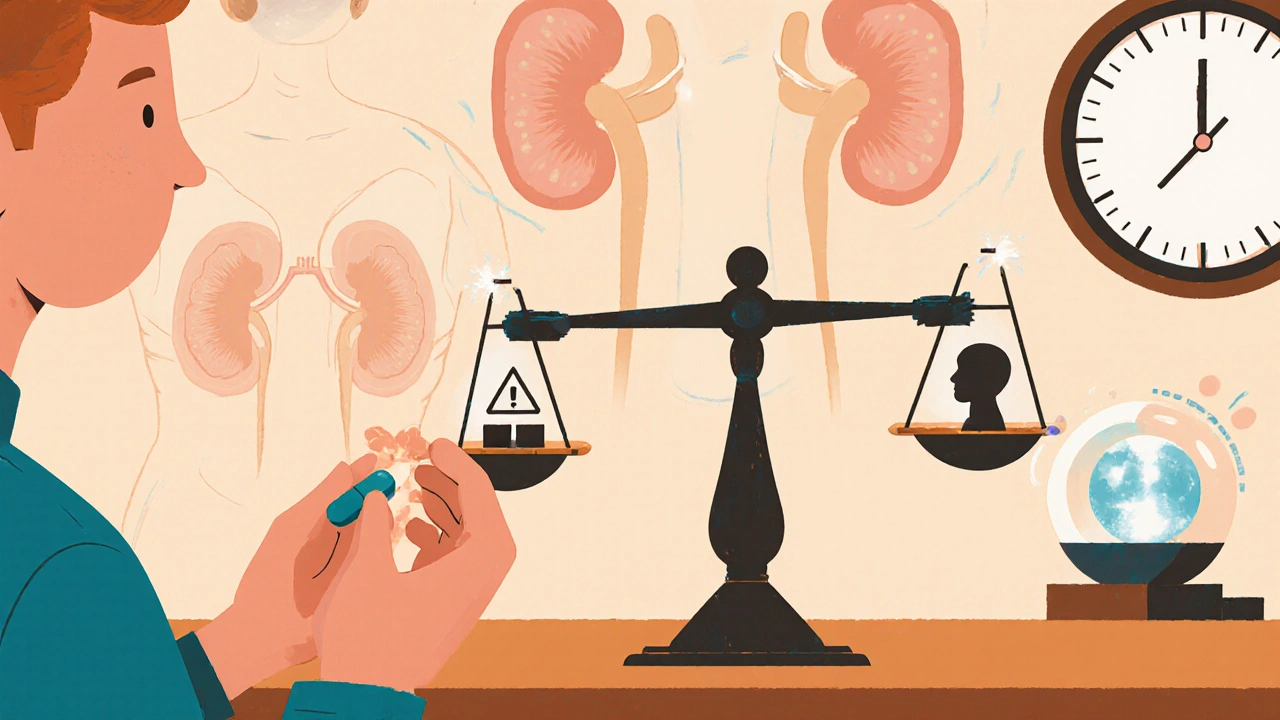Blood Pressure Medication Finder
Find Your Best Blood Pressure Medication
Answer a few questions to get personalized recommendations for blood pressure medications based on your health needs.
When your doctor prescribes a pill for high blood pressure, you want to know how it stacks up against other options. Losartan, sold under the brand name Cozaar, is one of the most common choices, but it isn’t the only game‑in‑town. Below you’ll find a straight‑forward look at what Losartan does, who should (or shouldn’t) take it, and how it compares to the most popular alternatives.
What is Losartan (Cozaar)?
Losartan is an angiotensin II receptor blocker (ARB) used to lower blood pressure and protect the kidneys in people with diabetes. It was approved by the FDA in 1995 and is sold worldwide under the brand name Cozaar. The drug works by stopping angiotensin II-a hormone that tightens blood vessels-from binding to its receptor. The result is relaxed vessels and easier blood flow.
Key facts at a glance
- Typical starting dose: 50 mg once daily; can be increased to 100 mg.
- Half‑life: about 2 hours, but its active metabolite lasts 6‑9 hours, allowing once‑daily dosing.
- Common side effects: dizziness, low potassium, mild kidney‑function changes.
- Contra‑indications: pregnancy, severe liver disease, known allergy to ARBs.
Why compare? 5 decision factors you’ll actually use
Choosing a blood‑pressure pill isn’t just about price. Here are five criteria that most patients and doctors weigh:
- Efficacy - How well does the drug lower systolic and diastolic pressure?
- Safety profile - Risks of cough, high potassium, kidney impact, or birth defects.
- Dosing convenience - Once a day vs. twice a day, with or without food.
- Cost & insurance coverage - Generic availability, co‑pay differences.
- Drug interactions - How it plays with other meds you might already take.
Alternative ARBs: the closest cousins
If you like the idea of an ARB but wonder whether something else might work better, these are the most prescribed:
- Valsartan (Diovan) - Often chosen for heart‑failure patients; similar blood‑pressure drop.
- Irbesartan (Avapro) - Slightly stronger effect on protein‑urine loss in diabetics.
- Telmisartan (Micardis) - Longest half‑life; can be taken at any time of day.
- Olmesartan (Benicar) - May cause a rare intestinal issue (sprue‑like enteropathy).
All four share the ARB mechanism, so their safety concerns (no cough, lower risk of high potassium compared with ACE inhibitors) are alike. The differences lie in how long they stay in the body and tiny variations in how aggressively they lower pressure.
ACE inhibitors: the older sibling group
Angiotensin‑converting‑enzyme (ACE) inhibitors block the production of angiotensin II rather than its receptor. They’re effective but come with a distinct side effect: a dry cough.
- Lisinopril - Usually started at 10 mg once daily; works well for hypertension and heart failure.
- Enalapril - Often prescribed in split doses; useful for patients with kidney disease.
ACE inhibitors tend to be a bit cheaper than ARBs, but the cough can force a switch to an ARB like Losartan.
Non‑ARB, non‑ACE options
When blood‑pressure goals aren’t met with a single pill, doctors often add a different class:
- Amlodipine (Calcium‑channel blocker) - Good for people with isolated systolic hypertension; taken once daily.
- Hydrochlorothiazide (Thiazide diuretic) - Low‑cost, works well in combination therapy; can raise uric acid levels.
These aren’t direct competitors to Losartan, but they’re common partners in combination pills.
Head‑to‑head: Losartan vs. its alternatives
| Drug | Class | Typical dose | BP‑lowering effect (mmHg) | Common side‑effects | Cost (generic US$ per month) |
|---|---|---|---|---|---|
| Losartan (Cozaar) | ARB | 50‑100 mg QD | ~‑10 / ‑6 | Dizziness, high K⁺, mild kidney change | ≈ $8‑$12 |
| Valsartan | ARB | 80‑320 mg QD | ~‑9 / ‑5 | Dizziness, back pain | ≈ $10‑$15 |
| Irbesartan | ARB | 150‑300 mg QD | ~‑11 / ‑7 | Fatigue, constipation | ≈ $12‑$18 |
| Lisinopril | ACE‑I | 10‑40 mg QD | ~‑12 / ‑8 | Cough, elevated K⁺ | ≈ $5‑$9 |
| Amlodipine | Calcium‑channel blocker | 5‑10 mg QD | ~‑8 / ‑5 | Swelling, flushing | ≈ $6‑$11 |
The numbers above are averages from major hypertension trials published between 2018‑2023. Losartan’s drop in systolic pressure is comparable to Valsartan and Irbesartan, a shade less than Lisinopril, and a bit more than Amlodipine.
When Losartan is the right pick
Pick Losartan if you meet any of these conditions:
- You have chronic kidney disease and need a drug that reduces protein loss.
- You’ve tried an ACE inhibitor and got a dry cough.
- Once‑daily dosing fits your lifestyle better than a twice‑daily regimen.
- You prefer a relatively inexpensive generic that is widely covered by insurance.
When another drug might beat Losartan
Consider switching if you notice:
- Persistent high potassium (≥5.5 mmol/L) despite diet changes.
- Signs of reduced kidney function (eGFR drop >30%).
- Need for a stronger systolic drop; Telmisartan’s longer half‑life can offer extra control.
- Cost is a primary concern and a cheaper ACE inhibitor is fully covered.
Common drug‑interaction pitfalls
Because Losartan is eliminated through the kidneys, combine it carefully with:
- Potassium‑sparing diuretics (e.g., spironolactone) - may push K⁺ too high.
- Non‑steroidal anti‑inflammatory drugs (NSAIDs) - can blunt the blood‑pressure‑lowering effect and stress kidneys.
- Azathioprine - rare interaction that raises azathioprine levels.
The same cautions apply to most ARBs, so the interaction profile isn’t a decisive factor when choosing between them.
Practical checklist before you start
- Confirm you’re not pregnant or planning pregnancy - Losartan is contraindicated.
- Check baseline potassium and kidney labs.
- Review all current meds for the three interaction groups above.
- Ask your pharmacist if a generic version is on the formulary.
- Schedule a follow‑up in 4‑6 weeks to reassess blood pressure and labs.

Bottom line summary
Losartan (Cozaar) holds its own against the most common blood‑pressure drugs. It offers solid efficacy, a clean safety record, and the convenience of once‑daily dosing. If you have kidney concerns, a cough from ACE inhibitors, or need a cost‑effective generic, Losartan is a strong contender. For patients who need a longer‑acting ARB or who struggle with potassium, Telmisartan or Irbesartan may be better fits. Always let your clinician run labs after the first month and adjust based on how you feel.
Can I take Losartan with a diuretic?
Yes. Combining Losartan with a thiazide diuretic like hydrochlorothiazide is a common strategy. The pair often produces a bigger blood‑pressure drop than either drug alone. Your doctor will watch potassium and kidney labs closely.
Why does Losartan cause high potassium?
Losartan blocks angiotensin II, which normally signals the kidneys to excrete potassium. When that signal is blocked, the kidneys retain more potassium, leading to higher serum levels.
Is Losartan safe during pregnancy?
No. Losartan belongs to pregnancy‑category D. It can cause fetal kidney damage and other birth defects. Pregnant patients should switch to a medication like labetalol or methyldopa.
How soon will I feel the effect of Losartan?
Blood‑pressure lowering starts within a few hours, but the full effect may take 2‑4 weeks as the body adjusts. Keep taking it as prescribed even if you don’t notice an immediate change.
What should I do if I miss a dose?
Take the missed tablet as soon as you remember, unless it’s almost time for the next dose. In that case, skip the missed one and continue with the regular schedule. Don’t double‑dose.


Nick M
October 21, 2025 AT 16:06Losartan’s market dominance feels like a pharma‑engineered monopoly, masking subtle renal‑risk signals.
eric smith
November 5, 2025 AT 16:53Oh, look, another generic ARB trying to pretend it’s the holy grail of hypertension management.
Newsflash: the efficacy gap between Losartan and its cousins is measured in millimeters of mercury, not miracles.
So unless you’re allergic to plain English, stick with the data.
Brandy Eichberger
November 20, 2025 AT 18:40For those who appreciate a nuanced view, Losartan offers a respectable balance of potency and tolerability.
Its pharmacokinetic profile is modest, yet it sidesteps the tormenting cough associated with ACE inhibitors.
In a world of blanket prescriptions, it’s refreshing to have a drug that respects the patient’s individuality.
Consider it the understated aristocrat of antihypertensives.
Eli Soler Caralt
December 5, 2025 AT 20:26i guess we could call losartan the "quiet philosopher" of blood pressure meds, quietly nudging vessels open while most drugs shout about side‑effects 😊
its subtlety makes me wonder if the market’s hype is just a reflection of louder advertising, not deeper science.
still, the gentle vibe aligns with a more meditative approach to health.
Eryn Wells
December 20, 2025 AT 22:13Hey folks! If you’re navigating the sea of antihypertensives, remember that cultural background can shape how you experience side‑effects.
Sharing your stories helps everyone find the right fit, and community support can make the journey less intimidating 😊
Let’s lift each other up while we chase healthier blood pressures.